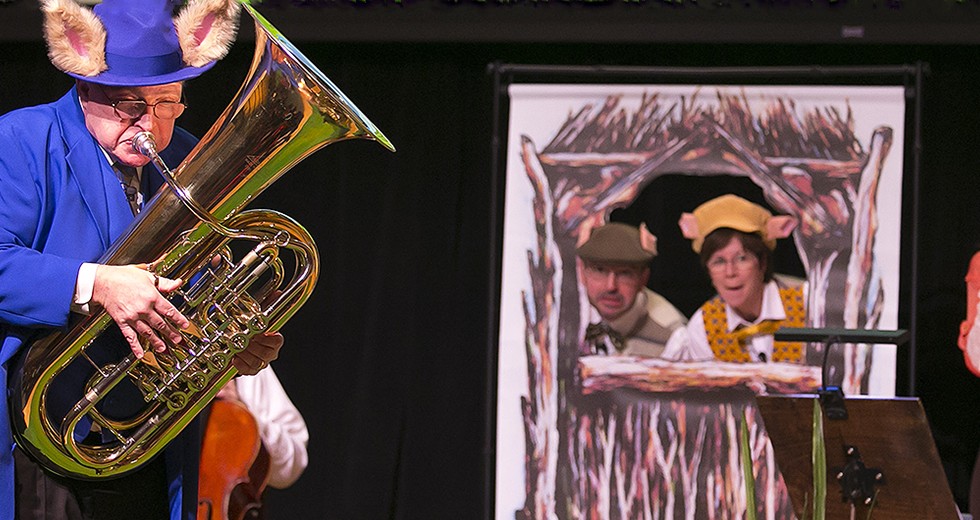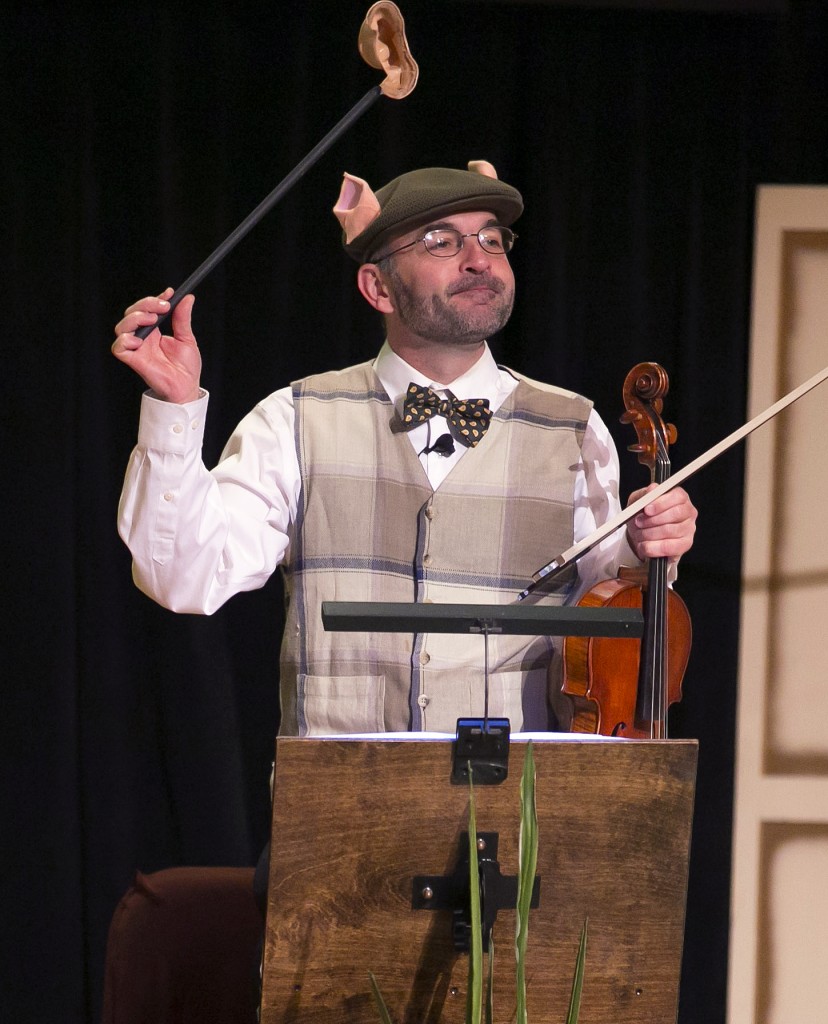
Baird Dodge admits he was a little jealous that Gene Pokorny and his tuba attracted the most young fans after the CSO’s Once Upon a Symphony performances of “The Three Little Pigs” last season. Pokorny played the Big Bad Wolf, and was “a great performer” in the role, said Dodge, the CSO’s principal second violin, who played the viola as one of the pigs.
During the performance, which required the quartet of musicians — including a flute and a cello (plus a storyteller) — to carry challenging pieces like Till Eulenspiegel’s Merry Pranks while wearing whimsical costumes, speaking lines and maybe blowing down a house or two, Pokorny would turn around every now and then and wiggle his big wolf tail at the audience members: young children and their parents.
“They loved him,” Dodge said. “The kids hit all the instruments after the show, but the tuba had the biggest crowd.”

Baird Dodge, CSO principal second violin, gets into the spirit of his role in “The Three Little Pigs.” | © Todd Rosenberg Photography 2014
Neither Pokorny, the CSO’s principal tuba, nor Dodge will appear in “The Little Red Hen,” the latest Once Upon a Symphony production for pre-school children, opening Jan. 10, but Dodge’s experience in “Three Little Pigs” demonstrates how passionate the world-class musicians who perform in these shows are about “giving young kids an engaging first contact with classical music,” he said.
For “The Little Red Hen,” CSO musicians Susan Synnestvedt will play the violin, Catherine Brubaker will be on viola and Daniel Armstrong will be featured on bass in three public weekend performances running Jan. 10 to March 7. (School groups will enjoy additional weekday performances.) They will be in costume as, respectively, a pig, a cow and a horse. Actor Lily Emerson, as the plucky Little Red Hen, will sing and play the banjo as well.
Designed for children ages 3 to 5 years old, the Once Upon a Symphony programs put CSO musicians front and center with the makings of a brand-new audience for classical music. Behind the scenes, a huge amount of thought and planning has gone into making these shows a memorable experience for families. “Jack and the Beanstalk,” the next production in the series, will begin April 11.
Chicago Children’s Theatre helps out with “the engagement piece” — story, sets, costumes and design elements — and works with the musicians, “who are not actors by trade,” said Jacqueline Russell, CCT co-founder and artistic director. “Our role has been to help the CSO focus on age-appropriate storytelling.”
Meanwhile, the music-education department at DePaul University developed the series’ pre-concert segment, designed to help prepare children for what might be their first experience with classical music.
The celebrated cellist Yo-Yo Ma, the CSO’s Judson and Joyce Green Creative Consultant, was deeply involved in developing the concept for Once Upon a Symphony. “We spent almost a whole year working with him,” said Jon Weber, director of learning programs for the Negaunee Music Institute at the Chicago Symphony Orchestra. “One of the keys for him — and this is imperative from a developmental point of view — was that there had to be interactive storytelling. The musicians are involved in non-musical ways. They get to come out from behind the music stand.”
Children tend to associate music they hear with elements of stories, and pieces are chosen for the Once Upon a Symphony concerts primarily for their ability to “create interest, to connect,” Weber said. “The Little Red Hen” is typical in that it will include “some pieces the audience will hear throughout their lifetimes,” mostly but not exclusively classical music.
For this production, a key piece is the first movement of Haydn’s Symphony No. 83, which has a rhythmic motif suggested by its nickname, “The Hen.” Another is an excerpt from Saint-Saëns’ Carnival of the Animals. The Shaker song “Simple Gifts” is part of the mix as well.
“What Jon has done is to make it easier for the really young kids, by marrying the music to stories they are already somewhat familiar with,” Dodge said. “It’s a small step instead of a big leap.”
An important aspect of the concerts, Weber points out, is the pre-concert segment where the audience gets a chance to engage with some of the concepts the music will present. These segments are led by DePaul University music-education students.
“It’s easier for kids to understand if they can relate,” said Jacqueline Kelly-McHale, associate professor and coordinator of music education at DePaul’s School of Music. “What do those animals sound like? Is a hen fast or slow? We talk about what [children hear in the music]. We move like hens. We act it out.”
The children witness how the story will unfold in the music. For example, the Little Red Hen is excited to see the wheat growing, and with it, her hopes of making delicious bread. As the wheat grows taller, the music gets louder, until it reaches a crescendo that is “visual, aural and kinesthetic,” Kelly-McHale said. “At the concert, after the lessons, you can see that recognition when [the children] hear the music.”
All the shows have an upbeat lesson, too. At the end of this concert, the animals too busy to help with the bread-making have an opportunity to reflect on their behavior, and as Weber notes, everyone decides “that sharing of yourself is better than being selfish.”
Delia O’Hara is a Chicago-based writer. Her short story, “Jonah,” was a runner-up in the 2013 Nelson Algren Award contest for short fiction.
TOP: Gene Pokorny, CSO principal tuba, huffs and puffs as the Big Bad Wolf in the Once Upon a Symphony production of “The Three Little Pigs.” | © Todd Rosenberg Photography 2014